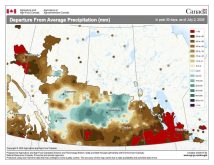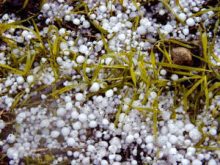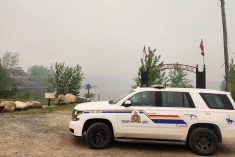Growing conditions on the Canadian Prairies will be very different if global warming trends continue — but how different?
A new series of online maps offers a glimpse of the length of season, temperature changes and rainfall farmers in the not-so-distant future could face under various scenarios.
The maps are part of a ‘climate atlas’ being developed as a joint venture between the University of Winnipeg and the International Institute for Sustainable Development (IISD).
Data is now being posted online (climate.uwinnipeg.ca) with much more to come, said Danny Blair, the climatologist at the University of Winnipeg leading a research team on the project.
“What we’ll soon have, that will be of interest to the agricultural community and others, are maps showing the changes to the length of the growing season, changes to the timing of the first frost in the fall and last frost in the spring, changes in corn heat units, change in degree days of various kinds, and the number of cold days and hot days per year,” said Blair.
It’s a lot of complicated data but they’ve worked to format so that the climate atlas will show a range of climate change scenarios with an outlook as far as 2080, Blair said.

Climate models
The atlas will project a dozen different climate models, Blair said. That’s because there are many possible climate change scenarios, depending on how society addresses carbon emissions.
“It presents a range of climate models. You cannot choose just one and say ‘this is the future,’” he said.
The climate atlas initially began as a stand-alone project after the provincial climate change branch requested the researchers generate some data showing what Manitoba’s climate might look like 30 to 60 years from now.
But it’s become clear that resources and expertise for adaptative planning and implementation aren’t available to citizens, community planners and policy-makers. Developers realized this data shouldn’t remain confined to academic circles or internal government reports, but instead be translated into language and formats the public will find useful.
Read Also

Canadian canola prices hinge on rain forecast
Canola markets took a good hit during the week ending July 11, 2025, on the thought that the Canadian crop will yield well despite dry weather.
“So we made a pitch to the province for the need for a larger project which was to not only generate this data, but to work with the community and show how climate change is likely to impact their activities, and how they might have to prepare for it,” Blair added.
That’s where the Winnipeg-based Prairie Climate Centre comes in.
The province earlier this year pledged $400,000 over two years to support the launch of the centre. Great West Life has also pledged $250,000.
High-quality data
The Prairie Climate Centre provides stakeholders in Manitoba and across the Prairies with this kind of up-to-date and high-quality data depicting the nature of climate changes expected to occur, said Henry (Hank) Venema, director of planning for the centre, which will be housed at the University of Winnipeg’s Richardson College for the Environment.
“Other organizations in Canada that have a climate change focus are typically university based and are more focused on academic research,” he said.
“What we’re trying to do is inform stakeholders and various resource industry sectors about what the potential climate change impact may be, and adaptation solutions. That’s the niche we’re filling.”
Venema said the centre is now operational and its partnership with University of Winnipeg well established.
The centre will reach out to all types of resource-based industries and other stakeholders across the three Prairie provinces. Municipalities, for example, will find data generated by the centre useful for water management planning, for example.
“One of the key issues municipalities face are decisions around water infrastructure,” he said. “We anticipate that some of our data products will provide information around how drainage could be sized differently to account for high rainfall, for example.
“The insurance industry is also very interested in this information,” he added.
Venema said the PCC team right now is trying to find out from users’ perspective what information they need.
“That will influence how we package the information we have and how we access other info that’s available,” he said.
The focus of the PCC will initially be on Manitoba but will also extend to Saskatchewan and Alberta, he said.




















